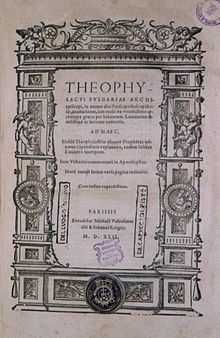Theophylact of Ohrid
| Theophylact of Ohrid | |
|---|---|
|
Icon of Theophylact | |
| Born |
~1050 Euripus, Euboea |
| Died | 1107+ |
| Venerated in | Eastern Orthodox Church |
| Feast | December 31 |
| Patronage | Ohrid |
Theophylact of Ohrid (Greek Θεοφύλακτος, surname¨Ηφαιστος, Bulgarian Теофилакт Охридски, Serbian Теофилакт Охридски, also known as Theophylact of Bulgaria) (around 1055–after 1107) was a Greek archbishop of Ohrid and commentator on the Bible.
Life
He was born most probably at Euripus, in Euboea, about the middle of the 11th century. He became a deacon at Constantinople, attained a high reputation as a scholar, and became the tutor of Constantine Ducas, son of the Emperor Michael VII, for whom he wrote The Education of Princes. About 1078 he went into Bulgaria as archbishop of Achrida (modern Ohrid).
Ohrid was one of the capital cities of the First Bulgarian Empire that had been conquered by the Byzantines sixty years earlier. In this demanding position in a conquered territory on the outskirts of the Byzantine Empire, he conscientiously and energetically carried out his pastoral duties over the course of the next twenty years. Although a Byzantine by upbringing and outlook, he was a diligent archpastor of the Bulgarian Church, defending its interests and autonomy (i.e. its independence from the Patriarchate of Constantinople). He acted vigorously to protect his archdiocese from the teachings of the Paulicians and Bogomils (considered heresy by the Orthodox Church). He won the respect and love of the Bulgarian people who witnessed his labors on their behalf.[1]
In his Letters he complains much about the rude manners of the Bulgarians, and he sought to be relieved of his office, but apparently without success. "His letters from Ohrid are a valuable source for the economic, social, and political history of Bulgaria as well as Byzantine prosopography. They are filled with conventional complaints concerning Theophylact's 'barbarian' surroundings, whereas in fact he was deeply involved in local cultural development, producing an encomium of 15 martyrs of Tiberioupolis and a vita of Clement of Ohrid."[2] He also wrote (in his Letters) accounts of how the constant wars between the Byzantine Empire and the Pechenegs, Magyars and Normans had destroyed most of the food of the land and caused many people to flee to the forests from the towns.
His death took place after 1107.
The present day Orthodox Churches of Serbia, Bulgaria, Greece, and Russia consider him to be a saint, and commemorate him on December 31.[3]
Works

His commentaries on the Gospels, Acts, the Pauline epistles and the Minor prophets are founded on those of Chrysostom, but deserve the considerable place they hold in exegetical literature for their appositeness, sobriety, accuracy and judiciousness. His other extant works include 530 letters and various homilies and orations, the Life of Clement of Ohrid known as Comprehensive, and other minor pieces. A careful edition of nearly all his writings, in Greek and Latin, with a preliminary dissertation, was published by JFBM de Rossi (4 vols. fol., Venice). The edition was reprinted by J.-P. Migne in the Patrologia Graeca vols. 123-6 (1869).
St Thomas Aquinas, the celebrated western Christian theologian, included parts of Theophylact's writings in his Catena Aurea, which is a collection of commentary on the four Gospels by the Church Fathers.
In the early 16th century, his Scripture commentaries had an important influence on the Novum Testamentum and Annotationes of Desiderius Erasmus, though Erasmus mistakenly referred to him as "Vulgarius" in early editions of his New Testament. Theophylact's commentaries on the Gospels were published in the original Greek in Rome in 1542, and had been published in Latin by both Catholic (Porsena) and Protestant (Oecolampadius) translators in the 1520s. Contemporary translations of Theophylact's commentaries are available in modern Greek, Russian, Serbian, Bulgarian, and Romanian, reflecting the wide influence of his exegetical work within the Orthodox Church, and beyond. A twentieth century Bishop of Ohrid, Nikolai Velimirovic, writes, "Theophylact's commentaries on the Four Gospels and on other books of the New Testament ... are the finest works of their sort after St John Chrysostom, and are read to this day with great benefit."[4]
The first English translation (and the first in any modern Western European language) of Theophylact's commentaries on the New Testament, The Explanation of the Gospels, is available from Chrysostom Press . Work is underway to complete the English translation of his commentaries on the Book of Acts and the Epistles.
The Epistles of Galatians and Ephesians have now been published (2012-2013), and translation is underway for Corinthians and Philippians.
Notes
- ↑ Dimitri Obolensky, Six Byzantine Portraits, Oxford, Clarendon Press, 1988, pp. 34-82.
- ↑ The Oxford Dictionary of Byzantium, Oxford University Press, 1991, Vol. 3. p. 2068
- ↑ The Prologue From Ochrid, Bp. Nikolai Velimirovic, Lazarica Press, Birmingham, England, 1985, Vol. 4, p. 393.
- ↑ POMOG - Protection of the Mother of God Church, Rochester NY
References
- Marcella Carolina Labruna, Teofilatto di Ocrida e la riforma del sistema scolastico a Bisanzio nell'XI sec., Valdinoto, 2, 2006
- Karl Krumbacher, Byzantinische Litteraturgeschichte (2nd ed. 1897) pp. 132, 463.
- John Julian Norwich. Byzantium: The Decline and Fall. New York: Alfred A. Knopf, 1996.
![]() This article incorporates text from a publication now in the public domain: Chisholm, Hugh, ed. (1911). Encyclopædia Britannica (11th ed.). Cambridge University Press..
This article incorporates text from a publication now in the public domain: Chisholm, Hugh, ed. (1911). Encyclopædia Britannica (11th ed.). Cambridge University Press..
- Margaret Mullett, Theophylact of Ochrid: Reading the Letters of a Byzantine Archbishop, Aldershot, Ashgate Variorum, 1997.
External links
| Wikimedia Commons has media related to Theophylact of Ohrid. |
- Chrysostom Press (Publisher of Bl. Theophylact's Commentaries on the New Testament)
- Theophylact of Ohrid. Bibles commentaries (in Russian)
| Orthodox Church titles | ||
|---|---|---|
| Preceded by John III of Ohrid |
Archbishop of Ohrid 1084–1108 |
Succeeded by Leo II Mung |
